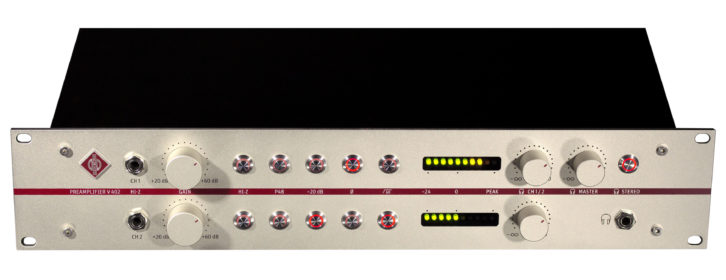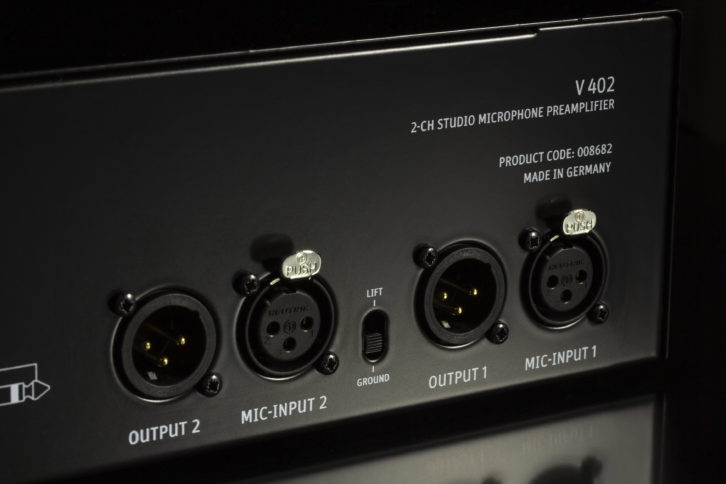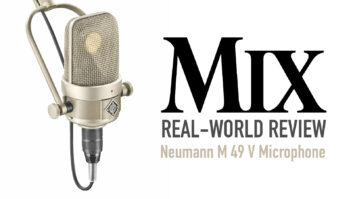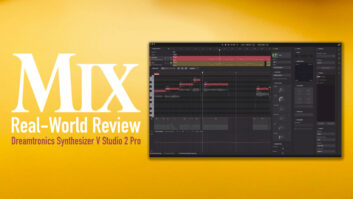
Microphones have been Neumann‘s bread and butter since the company’s founding back in 1928. However, the vaunted German manufacturer does sometimes branch out into other types of studio gear, including the KH line of studio monitors, NDH 20 headphones and the recently released V 402 preamp.
The V 402 is not the first mic preamp Neumann has manufactured, but it’s the first standalone one. The company made the PMV 70 back in the 1970s, along with its successor the V 476 B, both of which were used in mixing consoles. The latter was featured in the mixers manufactured by Neumann during the 1980s.
But unlike its predecessors, the V 402 is transformerless and designed to be as transparent as possible. If I may make a Star Trek analogy, the V 402’s “prime directive” is complete neutrality, to neither add nor detract from the microphone’s sound. Considering the quality of Neumann microphones, it’s an appealing concept.
Double Decker
The V 402 is a two-rackspace unit with Hi-Z inputs, a headphone output, and all of its controls on the front panel. The XLR I/O resides on the uncrowded back panel. The steel-bodied package weighs in at a relatively hefty 13.7 pounds and appears to be built solidly.
The faceplate is silver-colored and features a red Neumann logo badge—a color scheme reminiscent of the company’s classic mics. A red stripe bisects the front of the unit horizontally, dividing channels 1 and 2. Printed on the stripe in white type is common labeling for the jacks, knobs and switches above and below it.
The look is tasteful and understated—perhaps a little too much so from a visibility standpoint. When I got the V 402 review unit, I put it in my rack’s highest available space, which was up about 10 spaces from the bottom.
From there, it was approximately 18 inches away from me and I had to look down at it at a 45-degree angle. From that vantage point, I had difficulty reading the labels without bending down and moving in closer. I’m sure it would have been easier to see at eye level, but one doesn’t always have the luxury of positioning hardware optimally.
Across the Front Panel
Each channel’s controls are identical. The extra knob and button that you see on the top section’s far right is for the integrated headphone amp.
Starting on the far left of each channel is a ¼-inch unbalanced input for Hi-Z sources. The impedance is a healthy 3.3 megaohms, which is more than sufficient to capture all the high-end detail from the pickup (or pickups) of a guitar, bass or other DI instrument.
Next comes a large, stepped input Gain control knob. I counted more than 35 steps in it, so it allows for precise adjustments. The gain range for the mic inputs is +20 dB to +60 dB, and for the Hi-Z inputs, 0 dB to +40 dB. (Those specs are with the unit’s -20dB Pad off).
Each channel sports five backlit switches that allow you to turn on and off various preamp functions. The furthest left button activates the Hi-Z input. Next is 48V phantom power. Right after that is the switch for the Pad. Then comes a Phase (polarity) reverse switch, followed by a 60Hz highpass filter with a -12dB/octave rolloff.
At a Glance
Both channels feature a horizontally oriented 10-segment, color-coded, bar-graph meter, where each step represents 6 dB. The LEDs light up green when you’re in the meter’s main range, yellow when you get close to overloading and red when you overload. If your level reaches the highest step of the meter (which is +24 dBu), the Peak Hold function kicks in and the step stays red for three seconds, making it easier to notice when you’ve clipped.
The LEDs are big, and the meters are visible from a good distance. If you record in a home studio and are mainly working by yourself, that visibility is helpful. When I was recording vocals and had to position myself several feet back from the unit, I was able to see the meter clearly. In that circumstance, I also appreciated the Peak Hold feature.
On the far right is the headphone amp section. It contains Gain knobs for each channel, a Master Volume that governs both, a Mono/Stereo button, and a quarter-inch TRS headphone output.
Because so much of the functionality of the V 402 is accessed from the front panel, there isn’t much that needs to go on the back. On one side is the Mains Power switch and an IEC mains socket. On the other side are XLR inputs and outputs for the two channels.
Also included is a Ground Lift switch, which is nice to have when necessary. That’s it. If you’re using the unit in a crowded rack, you may need to control the power from an external switch if you can’t reach around to turn the V 402 on or off.
The Sound of Neumann
The functionality is straightforward. Neumann didn’t even produce a full manual for the V 402, just a Quick Start Guide. When reviewing the unit, I tested it out on a lot of different sources, and the results were uniformly impressive. Based on the recording I did through it, I can confidently state that Neumann succeeded in its goal of making the V 402 transparent.
One test involved recording several acoustic instruments, including guitar, Dobro, banjo and mandolin. I find that organic sources like that are useful for checking the quality of your chain. I recorded each one separately through the V 402, using three different mics: an Oktava MK-012-01 pencil condenser, a Neat Microphones King Bee large-diaphragm condenser and a beyerdynamic M1 ribbon mic.
Although it was subtle, all the mics exhibited a little more clarity than I’ve heard when using other preamps, with the character of each appearing to come through more. When recording the acoustic guitars, I engaged the High-Pass filter and was pleased with its impact. It took out the boominess but not the richness.
I also tried the V 402 out on some vocal tracks using a Mojave Audio MA-300 tube condenser. That mic works well on my voice, and the V 402 seemed to bring out the best in it. The vocal sound was a bit clearer and more present than when I use that mic through other preamps.
In my studio, I do a lot of recording of DI electric guitar and bass. During the time I had the V 402, I recorded many such tracks through its Hi-Z input. The results were clear, bright and present. The ultra-high impedance resulted in recordings that were bright and detailed. In an intangible way, the tracks seemed to have more energy.

In Your Head?
One of the more intriguing features on the V 402 is its headphone amp, which is not something you find all that often on a mic preamp. When I saw that it had separate gain controls for each channel, a master volume and a mono/stereo switch, I wondered what applications Neumann had in mind for it. One thing that jumps to mind is to use it for checking mic placement. It provides a super-accurate sonic picture before the signal goes through the A/D converter in your interface.
On the Neumann website, it says about the headphone amp: “Independent volume controls for each channel allow you to dial in a latency-free monitoring mix without affecting the recorded signal.”
Well, yes, but there’s a major sticking point: To have a latency-free monitor mix, you need to be able to connect a stereo line out from your DAW into the V 402. But the V 402 doesn’t have a line input. The only way you could get a monitor mix back into it is to feed a mono line out into one of the Hi-Z or mic inputs. But neither is stereo or at the correct signal level.
It’s too bad that they didn’t include a line input, because the headphone amp is incredible-sounding. I compared it against a couple of other outboard devices with headphone amps, and the V 402 was in another league. I can’t overstate how clean and clear it sounds.
Considering this is a premium unit, I’m puzzled as to why Neumann omitted something as obvious as a stereo line-in to complement the headphone amp. It’s frustrating because you have this great-sounding amp with limited usability. It’s like owning a sports car in an area with only dirt roads.
Provide Purity
Overall, though, the V 402 is quite impressive. At $1,450 per channel, it’s not likely to appeal to anyone on a budget. But if you can spring for it, it will provide you with a pristine signal path for your recordings.
If you’re looking for an instant upgrade in the quality of your studio’s mic preamps, it’s a worthwhile investment. Alternatively, it would make an excellent complement to a transformer-based mic preamp that adds color. For recording situations where the purity of signal is the priority, the V 402 is a fantastic unit to have in your rack.
PRODUCT SUMMARY
COMPANY: Neumann
PRODUCT: V 402
WEBSITE: neumann.com
PRICE: $2,900
PROS: Transformerless design yields clear sound. Extra-high impedance in Hi-Z inputs. Pristine-sounding headphone amp. Highly visible input meters. Peak Hold feature helps you see when you’re clipping. Heavy-duty housing. Neumann craftsmanship.
CONS: Headphone amp lacks line input for monitoring. Front panel labels can be hard to read.




